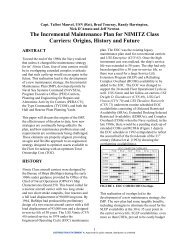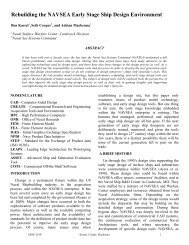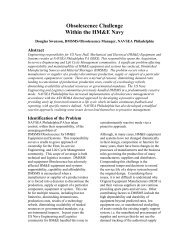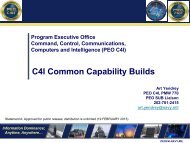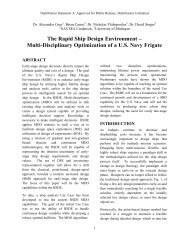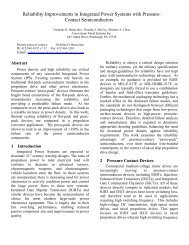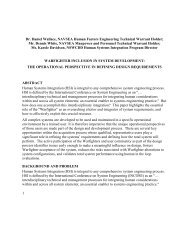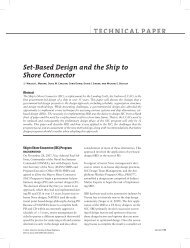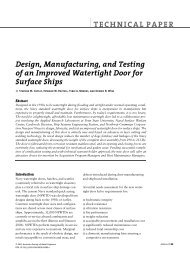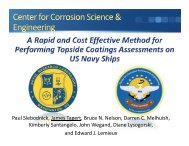The Wreck of DKM Bismarck − A Marine Forensics Analysis 1 The ...
The Wreck of DKM Bismarck − A Marine Forensics Analysis 1 The ...
The Wreck of DKM Bismarck − A Marine Forensics Analysis 1 The ...
You also want an ePaper? Increase the reach of your titles
YUMPU automatically turns print PDFs into web optimized ePapers that Google loves.
<strong>The</strong> <strong>Wreck</strong> <strong>of</strong> <strong>DKM</strong> <strong>Bismarck</strong> <strong>−</strong> A <strong>Marine</strong> <strong>Forensics</strong> <strong>Analysis</strong><br />
fact halted from propagating by the pre-existing battle damage. <strong>The</strong>re is some evidence<br />
supporting the latter scenario.<br />
As many as five torpedo hits on <strong>Bismarck</strong> were claimed during the final engagement on<br />
27 May 1941. None <strong>of</strong> these had any consequential effect on the outcome <strong>of</strong> the engagement,<br />
although they may have contributed to the massive destruction (aggravated by hydraulic<br />
outburst) that has been observed on the sea bed:<br />
○ Dorsetshire ─ Two hits claimed on the starboard side, at the turn <strong>of</strong> the bilge,<br />
locations unknown. One <strong>of</strong> these hits may have been in the vicinity <strong>of</strong> the middle<br />
150-mm turret on the starboard side, as observers on Dorsetshire claimed a hit<br />
amidships. As the wreck <strong>of</strong> <strong>Bismarck</strong> plummeted down the seamount on the sea<br />
bed, hull structure weakened by battle damage <strong>−</strong> primarily torpedo hits but also<br />
gunfire damage <strong>−</strong> ripped away. This makes the confirmation and localization <strong>of</strong><br />
torpedo damage over much <strong>of</strong> the hull structure impossible.<br />
○ Dorsetshire ─ A hit on the port side, as <strong>Bismarck</strong> was beginning to capsize. This<br />
torpedo struck on the port side abreast <strong>of</strong> the fore bridge tower, just forward <strong>of</strong><br />
turret 62. This torpedo ran onto or slightly above the main deck, probably<br />
detonating among the debris from the gunnery engagement. This may account for<br />
the damage to the boom<strong>of</strong> the port aircraft and boat crane.<br />
○ Rodney ─ A claimed torpedo hit on the starboard side, in way <strong>of</strong> Turret Bruno.<br />
<strong>The</strong>re was no visible evidence <strong>of</strong> this torpedo hit, but the mud line is fairly high in<br />
way <strong>of</strong> Turret Bruno. If this hit occurred around 1000 as reported, it may have<br />
struck below the bilge keel.<br />
○ Norfolk ─ A possible hit was observed on the starboard side aft in way <strong>of</strong> the after<br />
main battery turrets.<br />
<strong>The</strong>re is evidence <strong>of</strong> a possible torpedo hit on the starboard side aft in way <strong>of</strong> the after<br />
main battery turrets. A large flap <strong>of</strong> hull plating, bent outward and aft, may be physical evidence<br />
<strong>of</strong> this torpedo hit. <strong>The</strong> inner tank wall is holed in a manner consistent with a torpedo explosion,<br />
but just inboard from it the torpedo bulkhead is intact. Forward, the unaffected tank wall is<br />
vertically compressed, evidence <strong>of</strong> the ship’s powerful impact with the sea bed. It is impossible<br />
to determine with certainty if this is a torpedo hit because <strong>of</strong> the enormous influence <strong>of</strong> the<br />
hydraulic outburst that took place when the ship hit the seabed. <strong>The</strong> excretion <strong>of</strong> entrained water<br />
through damaged structure can enlarge the original damage, and can create pr<strong>of</strong>ound damage<br />
even in previously undamaged sections. However, this aft starboard hole seems to be our most<br />
unequivocal example <strong>of</strong> torpedo damage.<br />
One <strong>of</strong> the great challenges confronting a marine forensics analyst on analyzing a ship<br />
wreck is evaluating observed damage on the sea bed <strong>−</strong> determining what occurred on the surface<br />
that caused the ship to sink as opposed to damage caused during the sinking process, including<br />
the impact with the sea bed. In the case <strong>of</strong> <strong>Bismarck</strong>, the structural damage to the ship caused by<br />
impact was significantly greater than the battle damage. Impact effects, and subsequent events,<br />
such as the slide down the slope, must be clearly understood in order to accurately subtract them<br />
from the total damage in order to confirm the battle damage.<br />
33



